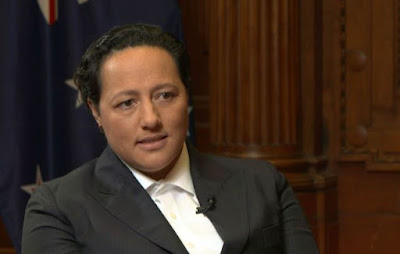 |
| Topsy-Turvy: Justice Minister Kiri Allan has got the direction of power and control in New Zealand completely upside-down. |
“AS A GOVERNOR.” That is how Justice Minister Kiri Allan described her political function on TVNZ’s Q+A. Unfortunately, Jessica Mutch McKay, standing in for Jack Tame, allowed Allan’s self-characterisation to pass without comment. Which was a pity, since it is highly unusual – unprecedented even – to hear a cabinet minister describe herself in such a fashion. In New Zealand’s down-to-earth democracy, calling oneself a “governor” is just a little bit weird.
New Zealand has had governors, of course, but not for a while. The Governor of New Zealand ruled in the name of the British sovereign, and was appointed by her government. A territory ruled by a governor may, or may not, be democratic, but everywhere and always their duties are exercised alone. There was only one governor in office at any given time in colonial New Zealand, just as there is only one governor in office at any given time in the USA’s fifty states. Being a governor is a job one does alone.
A semantic storm in a teacup? Well, no, not really. Ask a central government politician from New Zealand what they are, and by far the most common response is (or used to be) “I’m an MP.” Even when that MP was also a Cabinet Minister, it was generally left to others to introduce them as the minister of this, that, or the other. To personally flaunt one’s ministerial status in New Zealand was likely to provoke the observation that so-and-so was “a bit up themselves”.
When first encountered, the bureaucratic practice of always addressing the individual in possession of a royal warrant as “Minister” – in recognition of the office rather than the person – strikes most New Zealanders as excessively and ridiculously posh. The Kiwi instinct is to call politicians by their first and/or last names in preference to their titles. Hence, the present Prime Minister is called “Jacinda”, in exactly the same way that her predecessors were hailed as “Bill”, “John”, “Helen”, “Jim”, “David” and “Rob”. Exceptions were made for public servants, journalists, and those officiating at formal gatherings, because, well, it would be a bit rude not to. Otherwise, informality is the rule.
Parenthetically, this egalitarian informality has always struck the acutely status-conscious Brits as reprehensible. There is a famous story, dating from World War II, about the commander of the New Zealand Expeditionary Force, Bernard Fryberg, who was chastised by the punctilious commander of the British Eighth Army, Bernard Montgomery, for the way he failed to reprimand his men for not saluting senior officers. Unfazed, Fryberg responded by saying: “On the contrary, Sir, I find that if I wave at them, they generally wave back.”
A constitutional purist would, of course, object that Allan, as a member of the Cabinet, is part of the “Executive” which, under the Westminster System, constitutes the most active branch of government. Indeed, when New Zealanders refer to “The Government”, they are usually talking about the Cabinet, acting collectively. If Kiri Allan is engaged in actively governing the country, then why shouldn’t she refer to herself as a “governor”.
The most straightforward response to this question is: because she’s got the direction of power and control completely upside-down.
Historically, the Cabinet evolved out of the King’s or Queen’s council of advisers, that clique of powerful subjects among whom he, or she, distributed the great offices of state through which the realm was administered.
So far, so Henry VIII.
But, history does not stand still. The evolution of Cabinet government reflects the relentless disempowering of the British monarchy by Parliament, and the British people, to the point where, by the Eighteenth Century, its membership was restricted to those seated in the houses of parliament and appointed solely on the advice of the person commanding a reliable majority of the elected members of that parliament.
The New Zealand version of the Westminster System makes the direction of authority even clearer. Since 1950, this country has had only one parliamentary chamber – the House of Representatives. As its name implies, all the members of this “House” have been elected by the people to govern in their name. Meaning that, if anybody in this country has the right to describe themselves as “a governor”, it is the ordinary voter.
Kiri Allan sits at the Cabinet Table because the Prime Minister, Jacinda Ardern, advised the Governor-General, Dame Cindy Kiro, to issue her a ministerial warrant. The Prime Minister has that power because she commands a clear majority in the House of Representatives. If Allan loses the confidence of the Prime Minister, she ceases to be a Cabinet Minister. If Ardern loses the confidence of the House – or the next election – she ceases to be Prime Minister.
So far, so Politics 101.
Which only makes it all the more mysterious that Allan would ever begin a sentence with the words: “As a governor, …” At least until Sunday’s (30/10/22) Q+A, Allan’s reputation has been that of a rough-and-ready woman-of-the-people: someone not known for putting on airs-and-graces, but for being willing to call a spade a bloody shovel – and then use it. If Allan was to describe herself as anything, the smart money would have been on her calling herself the people’s “servant” – not their “governor”.
Certainly, Allan’s announcement – via Q+A – of her intention to go after the liquor industry is very much an example of leading by serving. She is responding to the anger and frustrations communicated to her by city councils and community advocates confronted with the paralysingly expensive legal obstructions erected by the alcohol distributors’ high-priced lawyers. That she is planning to do this by what looks suspiciously like a curbing of due-process (abolishing appeals and cross-examinations) only confirms what some observers describe as an almost reckless determination on the part of the Ardern Ministry to enact its more controversial reforms before the 2023 General Election.
Frustrated by the lethargy and incompetence of the public service; stung by mainstream media criticism; injured by social media attacks; and bitterly aware that its time is running out; the Labour Government is determined to leave a “progressive” legacy – even if it lasts only as long as it takes an incoming National-Act Government to repeal it.
It is even possible that some Labour leaders, and Allan may be one of them, are saying: “We have to give our core supporters at least some of the policies they requested – and we promised – because that’s the only way we can win.” Less optimistic (but possibly more Machiavellian) Labour strategists, by contrast, may counsel forcing National-Act to play the ruthless right-wing reactionaries, this time, so that Labour can win, next time.
If this is the way Labour’s thinking is heading, then Allan’s words are easily explained. People who know they are forcing a majority of the people to accept policies demanded by a minority, will always, under pressure, fall back on the blunt interrogatives of political power: Who has it, and who is willing to use it?
That’s why it is so easy to finish a sentence that begins, “As a governor”, with the words: “it is my will that prevails – not yours.” Easy, but a perilously long way from New Zealand’s egalitarian political traditions.
This essay was originally posted on the Interest.co.nz website on Monday, 31 October 2022.












